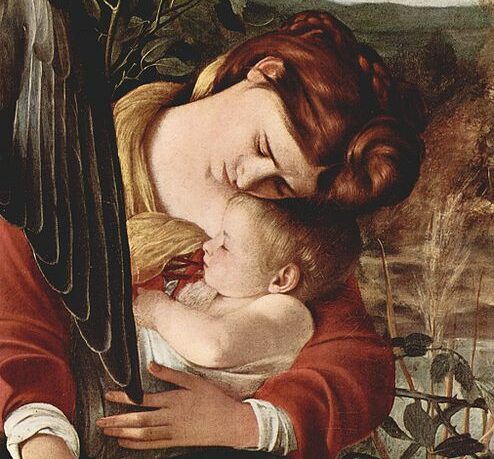
The Corporal Works of Mercy – To Shelter the Pilgrims
The Works of Mercy recommended by the Church do not have priority over one another, but all are of equal importance
One of the works of corporal mercy that touches us very closely today, given the social situation in which we find ourselves, is welcoming strangers and housing pilgrims.
By pilgrim we mean the stranger, the wanderer who moves from one place to another often in poverty and restlessness in search of a safe and desired destination. So many were the pilgrims, sometimes threatened with death, who had to leave everything behind and face dangerous paths. Caravaggio (1571/1610) made a masterpiece of this particular event. The “Rest in Egypt,” at the Doria Panphili Gallery (1597), in fact, tells precisely of the time when Joseph, in order to save his loved ones, faced that painful journey and arrived in the unknown land of Egypt.

The author, thanks to his profound faith in God’s mercy, imagines the event with a unique tenderness, plays on the deepest affections and humbly brings back in the image, the moment of the pause with an extraordinarily true naturalness. It is a poor family that the author describes. Mary with her head gently leaning against that of her son, is asleep. As one hand falls back on her lap, the other protects and holds, lest she fall, the plump baby who, unaware of what is happening, sleeps peacefully in his mother’s arms. Joseph awake and alert, sitting on the bag of supplies typical of peasants, like the water flask, holds open a book of music. Caravaggio, thanks to his exceptional talents and great creative ability, imagines what might have happened at that time.

Here the divine and the human meet. It is God who provides for the reception of these pilgrims, with a tenderness, with a gentleness, with a lovingkindness beyond the imaginable of mercy: he even sends an angel. This one, with such graceful and luminous forms, in the center of the group, replaces the human person and performs a gentle song and melodious music, perhaps a lullaby, on the violin. The panorama that opens up behind the figures is striking; it is nature with its cool shelters that shelters them. Everything is shot through with a soft, evening light, with warm tones and sweet chromatic effects that show a detailed analysis of every detail and eternalize the moment of rest, deserved at the end of a long day’s walk. But his impetuous character and desire to depict the true, sometimes brutal reality of life led him to the alleyways of the city of Rome where, still young, he went to learn the art of painting. Caravaggio struggles to put lunch and dinner together because some of his work is considered brutal realism and not very decent.

It was Cardinal Borghese who understood the artist’s great abilities and he was entrusted in 1604/1606 with the task of painting in the church of St. Augustine in Rome, the Madonna of the Pilgrims dedicated to the House of Loreto. In this painting we are now far from the traditional sacred images where the Virgin is often depicted with angels, enthroned and wearing, at times, regal clothing. The Madonna and Child, faces the threshold of a humble home, has modest clothes and the typical hairstyle of women of the people. She has delicate features and observes attentively the two wayfarers who have come to pray in the house of Loreto and who, astonished to find themselves before Mary, kneel with folded hands. Pilgrimage in those days was done on foot, and in the Jubilee of 1600 Caravaggio had surely observed those poor people who were so rich in faith that they faced long journeys and great difficulties. Even the Child, well restrained by his mother’s arms, raises the little finger of his right hand and turns to look with gentle interest at the pilgrims in poor, threadbare clothing in anxious anticipation. The brown and reddish tones, the grazing light highlighting every puzzling detail, make this work a moving participation in the lives of the humble and marginalized.

His masterpieces, often despised by the lords of his time, tell instead that true reality that demands respect toward that dignity that God has always recognized in the poor and sinners, responding to all, with his great mercy.
 Certainly today the attitude of those who seek hospitality in our lands, do not always have that resigned and humble attitude like the pilgrims depicted by Caravaggio, but they are always people in dire straits who cannot be denied the charity dictated by mercy.
Certainly today the attitude of those who seek hospitality in our lands, do not always have that resigned and humble attitude like the pilgrims depicted by Caravaggio, but they are always people in dire straits who cannot be denied the charity dictated by mercy.
